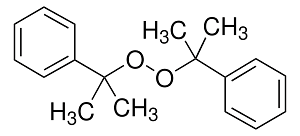Dicumyl Peroxide

Product Description
Dicumyl peroxide is a chemical compound widely used in various industrial applications.
Product:
Dicumyl Peroxide
CAS:
80-43-3
Synonym:
Bis(1-methyl-1-phenylethyl) peroxide; Bis(α,α-dimethylbenzyl) peroxide
Structure:

Typical Characteristics
Appearance
White to yellow solid
Boiling point
130 °C
Density
1.02 g/cm3
Flash Point
>110 °C
Melting point
39-41 °C
Molecular Weight
270.37
Purity
98%
Refractive index
1.5360
Uses, Applications & Markets
Key applications
get a quote
We Offer Dicumyl Peroxide
in various grades
A few of the grades available are listed below:



Dicumyl Peroxide used in many
industry applications
Dicumyl peroxide is a chemical compound widely used in various industrial applications. Here are some of its key uses:
- Initiator in Polymerization: Dicumyl peroxide is commonly employed as a free radical initiator in the polymerization of various monomers to produce polymers such as polyethylene, polypropylene, and rubber. It initiates the crosslinking or branching reactions, leading to the formation of thermosetting resins and elastomers with improved mechanical properties.
- Plastic and Rubber Industry: It serves as a curing agent or crosslinking agent in the manufacturing of thermosetting plastics, synthetic rubbers, and silicone elastomers. By initiating crosslinking reactions, dicumyl peroxide enhances the strength, durability, and heat resistance of these materials, making them suitable for applications in automotive parts, electrical insulation, and construction materials.
- Adhesives and Sealants: Dicumyl peroxide is utilized as a curing agent in the production of adhesive and sealant formulations. It facilitates the crosslinking of polymers in these formulations, improving their adhesion properties, chemical resistance, and performance in bonding applications for construction, automotive, and aerospace industries.
- Wire and Cable Insulation: In the wire and cable industry, dicumyl peroxide is used as a crosslinking agent in the production of insulation and sheathing materials for electrical cables. It helps enhance the thermal stability, mechanical strength, and electrical properties of the insulation, ensuring reliable performance and safety in electrical applications.
- Textile and Leather Processing: Dicumyl peroxide is employed in textile and leather processing as a curing agent or crosslinking agent for coatings, finishes, and laminates. It improves the durability, abrasion resistance, and colorfastness of textile fabrics and leather goods, enhancing their performance and appearance in various applications.
- Thermoset Composites: It is used in the production of thermoset composite materials reinforced with fibers such as fiberglass, carbon fiber, and aramid fiber. Dicumyl peroxide initiates the curing reactions of resin matrices, resulting in composite materials with high strength-to-weight ratios, excellent chemical resistance, and dimensional stability, suitable for aerospace, marine, and sporting goods applications.
- Other Applications: Dicumyl peroxide may also find use in other applications such as flame retardants, vulcanizing agents for rubber products, and as a chemical intermediate in the synthesis of organic compounds.